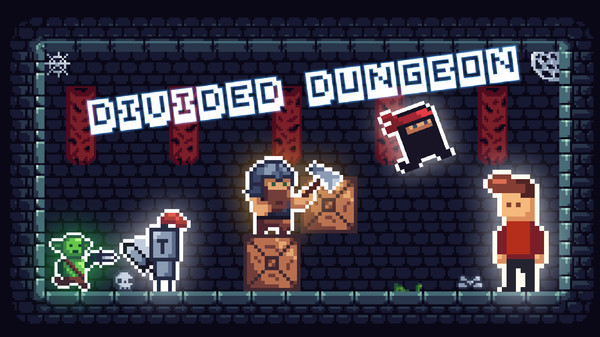Divided Dungeon Mac OS

Apple has released the iOS 14.5 and iPadOS 14.5 operating system update, adding the ability to unloc Chris Smith April 26, 2021 6:52 pm BST. Spotify is raising its subscription prices in the UK. The dungeon is divided into 40 floors, each with one staircase going up and one going down. The floor plan of each level is randomly generated, but remains unchanged throughout a single game. Though each level is about the same size, the complexity of the floor plans becomes more maze-like as the character descends to deeper dungeon levels. Dungeon Siege III is an Action RPG that seamlessly blends intuitive fast-paced gameplay, a robust RPG system featuring a large selection of abilities, loot galore and the depth of story Square-Enix and Obsidian Entertainment are known for creating. The dungeon is divided into 40 floors, each with one staircase going up, and one going down. The floor plan of each level is randomly generated, but remains unchanged throughout a single game. Though each level is about the same size, the complexity of the floor plans becomes more maze-like as the character descends to deeper dungeon levels.
| The Dungeon Revealed | |
|---|---|
| Developer(s) | John Raymonds |
| Publisher(s) | Woodrose Editions |
| Designer(s) | John Morgan |
| Programmer(s) | John Raymonds, David Russo |
| Artist(s) | Dan Ferguson |
| Platform(s) | Mac OS |
| Release | 1985–1987 |
| Genre(s) | Roguelike, dungeon crawl |
| Mode(s) | Single player |
The Dungeon Revealed is a dungeon crawlPC game created by John Raymonds and published by Woodrose Editions in 1987. A demo and shareware version of the game entitled The Dungeon of Doom were released in 1986 and 1987 respectively to promote the game. Both were released for Mac OS, and were compatible with versions as late as System 7.
Objective[edit]
The player controls a single character trapped in an underground dungeon. If the character attempts to take the stairs from the dungeon, a message appears: 'A force prevents you from escaping to the surface. Maybe the Orb will set you free...' Like this message, much of the game's story and mechanics are vague or undocumented. Most of the player's information comes from a window called Rumors, which contains 26 short, cryptic statements.
The dungeon is divided into 40 floors, each with one staircase going up and one going down. The floor plan of each level is randomly generated, but remains unchanged throughout a single game. Though each level is about the same size, the complexity of the floor plans becomes more maze-like as the character descends to deeper dungeon levels. There are also items, including weapons, armor, magical rings, scrolls, potions, wands, food items, and jewels placed randomly throughout the dungeon's floors.
Progress through the dungeon is hindered by monsters who, depending on the circumstances, have varying levels of hostility towards the character. The character must also eat periodically to avoid starvation. The monsters become more powerful and resistant to attack as the player progresses deeper into the dungeon.

Characters[edit]
The player begins the game by creating a new character from one of seven classes: knight, fighter, sage, wizard, alchemist, jeweler, and jones. Each class has a different set of attributes, parameterized similarly to Dungeons & Dragons, although the physical classes of knight and fighter are best as players will constantly have to fight to stay alive, whereas the ability to assess a potion, scroll, ring etc. is not especially useful and the nature of multiple items can be discovered using the very common identify scroll. Each attribute affects the character's abilities in a number of ways, many of which are undocumented. Characters with a high intelligence attribute, for example, have a higher probability of success when casting magic spells from a scroll, as well as an improved ability to map the dungeon. In addition, each class has an increased likelihood of being able to identify a certain type of item. Characters can improve their ability scores throughout the game, both temporarily and permanently, through the use of potions and scrolls.
Each class, with the exception of 'Jones', also has the unique ability to assess one type of object. Alchemists, for example, can accurately identify the potions they find in the dungeon, and therefore avoid drinking those with harmful effects, wizards wield wands more effectively, and so forth. All classes can reach the highest levels in each ability by obtaining a variety of scrolls and potions that raise strength, intelligence, wisdom, dexterity, constitution, and charisma. Strength controls a character's ability to attack, intelligence and wisdom, the ability to read and understand scrolls successfully, dexterity, the ability to wield weapons and throw objects, constitution the ability to withstand attack, and charisma, the ability to increase the odds a defeated monster will leave behind a useful item.
Divided Dungeon Mac Os X
The main objective of the game is to retrieve the orb of Carnos, located on the 40th level and guarded by a powerful boss monster called 'The Dark Wizard', who can be beaten relatively easily by standing in the staircase, reflecting all spell attacks. The 40th level also contains a second orb, made of plastic, which can only be identified using an 'identify scroll'.
Reception[edit]
Macworld named The Dungeon of Doom the 'Best Implementation of Rogue and 2-D Maze Game' as part of its Shareware and Public Domain Game Awards in 1987.[1]
References[edit]
- ^DeMaria, Rusel (November 1987). 'Shareware and Public Domain Game Awards'. Macworld. Mac Publishing. p. 164-165.
External links[edit]
- The Dungeon of Doom and The Dungeon Revealed are playable in browser at Archive.org
Divided Dungeon Mac Os Catalina
Divided Dungeon Mac OS
